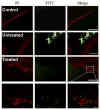Nanoparticle-based drug delivery to the vagina: a review
- PMID: 24830303
- PMCID: PMC4142075
- DOI: 10.1016/j.jconrel.2014.04.033
Nanoparticle-based drug delivery to the vagina: a review
Abstract
Vaginal drug administration can improve prophylaxis and treatment of many conditions affecting the female reproductive tract, including sexually transmitted diseases, fungal and bacterial infections, and cancer. However, achieving sustained local drug concentrations in the vagina can be challenging, due to the high permeability of the vaginal epithelium and expulsion of conventional soluble drug dosage forms. Nanoparticle-based drug delivery platforms have received considerable attention for vaginal drug delivery, as nanoparticles can provide sustained release, cellular targeting, and even intrinsic antimicrobial or adjuvant properties that can improve the potency and/or efficacy of prophylactic and therapeutic modalities. Here, we review the use of polymeric nanoparticles, liposomes, dendrimers, and inorganic nanoparticles for vaginal drug delivery. Although most of the work toward nanoparticle-based drug delivery in the vagina has been focused on HIV prevention, strategies for treatment and prevention of other sexually transmitted infections, treatment for reproductive tract cancer, and treatment of fungal and bacterial infections are also highlighted.
Keywords: Cervical cancer; HIV PrEP; Microbicides; Mucosal vaccines; Sexually transmitted infections.
Copyright © 2014 Elsevier B.V. All rights reserved.
Figures








Similar articles
-
Mucoadhesive nanosystems for vaginal microbicide development: friend or foe?Wiley Interdiscip Rev Nanomed Nanobiotechnol. 2011 Jul-Aug;3(4):389-99. doi: 10.1002/wnan.144. Epub 2011 Apr 19. Wiley Interdiscip Rev Nanomed Nanobiotechnol. 2011. PMID: 21506290 Review.
-
Advanced topical drug delivery system for the management of vaginal candidiasis.Drug Deliv. 2016;23(2):550-63. doi: 10.3109/10717544.2014.928760. Epub 2014 Jun 24. Drug Deliv. 2016. PMID: 24959937 Review.
-
Nanotechnology-Based Platforms for Vaginal Delivery of Peptide Microbicides.Curr Med Chem. 2021;28(22):4356-4379. doi: 10.2174/0929867328666201209095753. Curr Med Chem. 2021. PMID: 33297908 Review.
-
A review of current intravaginal drug delivery approaches employed for the prophylaxis of HIV/AIDS and prevention of sexually transmitted infections.AAPS PharmSciTech. 2008;9(2):505-20. doi: 10.1208/s12249-008-9073-5. Epub 2008 Apr 2. AAPS PharmSciTech. 2008. PMID: 18431651 Free PMC article. Review.
-
Nanocarriers For Vaginal Drug Delivery.Recent Pat Drug Deliv Formul. 2019;13(1):3-15. doi: 10.2174/1872211313666190215141507. Recent Pat Drug Deliv Formul. 2019. PMID: 30767755 Review.
Cited by
-
Hydrophobic-core PEGylated graft copolymer-stabilized nanoparticles composed of insoluble non-nucleoside reverse transcriptase inhibitors exhibit strong anti-HIV activity.Nanomedicine. 2016 Nov;12(8):2405-2413. doi: 10.1016/j.nano.2016.07.004. Epub 2016 Jul 25. Nanomedicine. 2016. PMID: 27456163 Free PMC article.
-
Release Kinetics of Metronidazole from 3D Printed Silicone Scaffolds for Sustained Application to the Female Reproductive Tract.Biomed Eng Adv. 2023 Jun;5:100078. doi: 10.1016/j.bea.2023.100078. Epub 2023 Feb 9. Biomed Eng Adv. 2023. PMID: 37123989 Free PMC article.
-
Development and Evaluation of Nanoparticles-in-Film Technology to Achieve Extended In Vivo Exposure of MK-2048 for HIV Prevention.Polymers (Basel). 2022 Mar 16;14(6):1196. doi: 10.3390/polym14061196. Polymers (Basel). 2022. PMID: 35335526 Free PMC article.
-
Nanomedicine for Maternal and Fetal Health.Small. 2024 Oct;20(41):e2303682. doi: 10.1002/smll.202303682. Epub 2023 Oct 10. Small. 2024. PMID: 37817368 Free PMC article. Review.
-
An effective vaginal gel to deliver CRISPR/Cas9 system encapsulated in poly (β-amino ester) nanoparticles for vaginal gene therapy.EBioMedicine. 2020 Aug;58:102897. doi: 10.1016/j.ebiom.2020.102897. Epub 2020 Jul 22. EBioMedicine. 2020. PMID: 32711250 Free PMC article.
References
-
- Ashok V, Kumar RM, Murali D, Chatterjee A. A review on vaginal route as a systemic drug delivery. Critical Review in Pharmaceutical Sciences. 2012;1:1–19.
-
- Alexander NJ, Baker E, Kaptein M, Karck U, Miller L, Zampaglione E. Why consider vaginal drug administration? Fertility and sterility. 2004;82:1–12. - PubMed
-
- Garg S. Vaginal Microbicide Formulations Workshop. Pharmaceutical Science & Technology Today. 1998;1:369.
-
- Odeblad E. Intracavitary Circulation of Aqueous Material in the Human Vagina. Acta obstetricia et gynecologica Scandinavica. 1964;43:360–368. - PubMed
Publication types
MeSH terms
Substances
Grants and funding
LinkOut - more resources
Full Text Sources
Other Literature Sources
Miscellaneous

